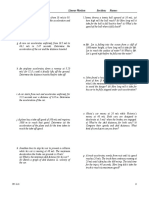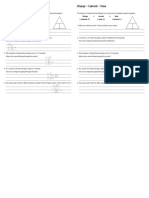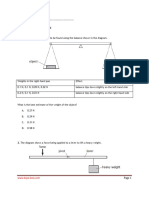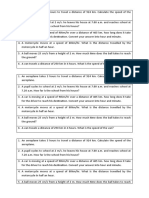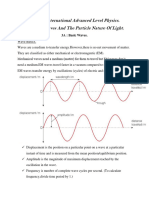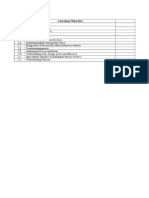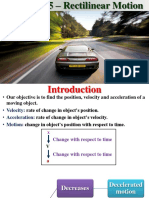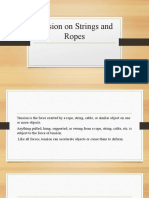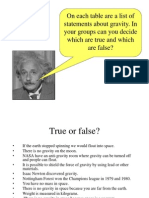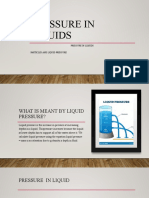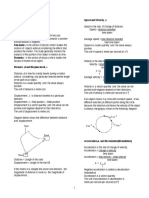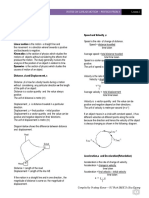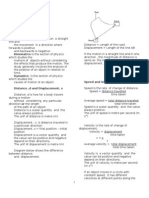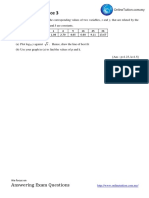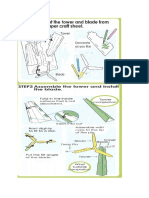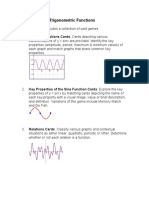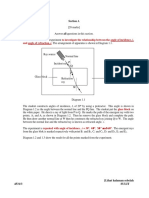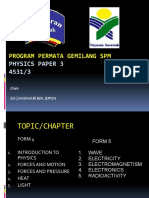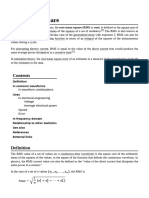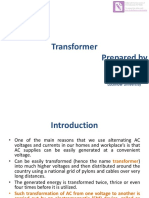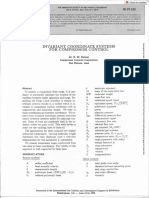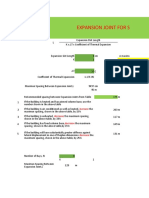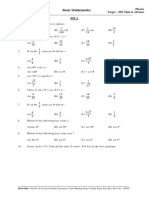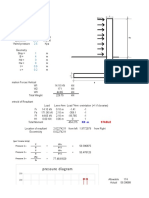LESSON 1
LINEAR MOTION
Speed and Velocity ,v
Introduction
Speed is the rate of change of distance.
Speed = distance travelled
time taken
Linear motion is the motion a straight line and
the movement in a direction where forwards is positive
and backwards is negative.
Kinematics is the section of physics which studies the
motions of objects without considering the effects that
produce the motion. The study generally involves the
analysis of the position of an object in relation to time.
Dynamics is the section of physics which studies the
causes of motion of an object.
Average speed = total distance traveled
total time taken
Speed is a scalar quantity and the value always
positive.
The unif of speed is metre per second (m s-1)
Velocity is the rate of change of displacement.
Velocity = displacement
time taken
v=s
t
Average velocity = total displacement
total time taken
Distance ,d and Displacement, s
Distance ,d is how far a body travels during a motion
without considering any particular direction or the length
of the path of an object.
Distance is a scalar quantity and the value always
positive.
The unif of distance is metre (m)
Velocity is a vector quantity and the value can be
positive and negative depend on their directions.
The unif of velocity is metre per second (m s-1)
Displacement , s is distance traveled in a particular
direction.
Displacement ,s = final position initial position
Displacement is a vector quantity and the value can be
positive and negative depend on their directions.
The unif of dispacement is metre (m)
If an object moves in a circle with constant speed , it has
different velocities at different points along the circle
because the direction and hence the velocity of the object
is always changing as shown in the following diagram.
Diagram below shows the difference between distance
and displacement.
Acceleration,a and Decelaration(Retardation)
Acceleration is the rate of change of velocity.
Acceleration = change in velocity
time taken
Acceleration = final velocity initial velocity
time taken
a = v - u
t
Negative acceleration is called as deceleration
(retardation)
Acceleration is a vector quantity
The unif of acceleration or deceleration is
metre per second per second (ms-2)
Distance = Length of the road
Displacement = Length of the line AB
If the motion in a straight line and in one direction , the
magnitude of distance is same as the magnitude of
displacement .
29
�Solution
Extra notes
Example 3
1
2
3
4
5
An object accelerates uniformly along a straight line from
a velocity of 10 m s-1 until 25 m s-1 in 5 s.
Calculate
(a)
the acceleration of the object
(b)
the velocity of the object during the first 10 s of
motion
(c)
the time taken to reach a final velocity 50 ms-1
6
7
uniform = constant = same
increasing velocity = acceleration
decreasing velocity (slow down) = deceleration
zero velocity = the object is stationary (at rest)
negative velocity = the object moves in opposite
direction
uniform velocity = zero acceleration
negative acceleration = deceleration
(retardation)
Solution
Example 1
A boy walks finish the following path AB.
Using a ticker timer to analysing the motion
Find
(a) total dinstance traveled
(b) displacement
A ticker timer is connected to an alternating electricity
supply (a.c.) and uses the mains electricity frequency of
50 Hz to make 50 ticks or vibrations every second.
1 tick is the time interval between one dot and the next
dot on the tape.
50 ticks = 1 s
1 tick = 0.02s
Solution
Example 4
Example 2
Based on the ticker tape above calculate
(a) time taken
(b) average volocity
Solution
Figure above shows runner runs 500 m towards east in
2 minutes and 1200m towards north in 4 minutes.
Calculate his
(a) average speed
(b) average velocity
30
�(d)
The type of motion based on ticker tape or tape chart
(a)
The type of motion is
velocity
acceleration
(b)
The type of motion is
velocity
acceleration
(e)
The type of motion is
velocity
acceleration
(c)
The type of motion is
velocity
The type of motion is
velocity
acceleration
31
acceleration
�Solution
Using Equations of Linear Motion with Uniform
Acceleration
The various equations of linear motions of an object
with uniform acceleration are given as follows:
v = u + at
s=
.(1)
u + v t ..(2)
2
s = ut + at2 ..(3)
v2 = u2 + 2as
..(4)
Where s :
u :...
v :...
a :
t :
Extra notes:
Example 12
moves from rest :
finally it stops/brakes:..
released from a height / fall freely from
rest :
thrown vertically upwards:..
at maximum height :.
A construction worker accidentally knocks a brick from a
building so that it falls in 4 s to the ground. Calculate
(a) the velocity of the brick as it hits the ground
(b) the distance fallen of the brick
Solution
Example 10
A car accelerates from rest to 25 m s-1 in 4 s.
Find the acceleration of the car.
Solution
Example 11
A bus accelerates uniformly along a straight line from a
velocity 20 ms-1 until 30 ms-1 in 5 s.
Calculate,
(a) the acceleration
(b) the total displacement travelled by the bus
32
TUTORIAL 1
A
C
E
1
A car moves with a constant velocity. The accelerationof
the car is
A
C
2
B
D
decreased
uniformly
0.60 s
0.32 s
0.20 s
B
D
0.44 s
0.30 s
Deceleration means the velocity of an object is
A
C
increased
zero
The frequency of a ticker timer is 50 Hz. The time
interval between two consecutive dots is
negative
increased
B
D
positive
decreased
Based on the figure above , calculate the average
velocity.
The following figure shows an object moves with a
constant speed 5 m s-1 in a circle.
A
C
E
8
0.2 ms-1
0.4 ms-1
0.5 ms-1
B
D
0.3 ms-1
0.5 ms-1
The following figure shows a tape chart.
The object is also moves with
A
B
C
4
an acceleration
zero acceleration
constant velocity
The figure shows a path of a moving object.
Based on figure , which of the following is true?
At the beginning of motion
A
If AB = 5m , BC = 5m and CD = 7m ,find the total
displacement of the object if it moves from A to D.
A
C
E
5
3m
13 m
20 m
B
D
7m
17 m
C
D
A tick on the ticker tapes is
A
B
C
D
the speed of the ticker timer
the frequency of the ticker timer
the dinstace between two consecutive dots
the time interval between two consecutive dots
33
the velocity
unchanged
the velocity
increases
the velocity
increases
the velocity
unchanged
At the end of motion
the acceleration
increases
the acceleration
increases
the acceleration
unchanged
the acceleration
unchanged
Which of the following shows an object moving with
decreasing acceleration ?
(a) Describe the type of motion is shown in the tape
chart.
...........................................................................................
...........................................................................................
(b) What is the time interval between two consecutive
dots ?
...........................................................................................
(c) Calculate
(i) the minimum velocity
(ii)
the maximum velocity
(iii) the average velocity.
10
A cyclist riding at a velocity 8 ms-1 and is accelerating
with 4 ms-2 . What is the velocity of the cyclist after 5 s .
A
C
E
11
B
D
20ms-1
28 ms-1
13
the acceleration.
Each figure below shows two positions of a student on a
swing. The initial position in each figure is different.
A car starts from rest and accelerates uniformly and
after travels at distance 45m the velocity of the car is
20 ms-1 . What is the time taken?
A
C
E
12
16 ms-1
24 ms-1
32 ms-1
(iv)
4.5 s
13.5 s
22.4 s
B
D
9.0 s
18.0 s
Observe the positions of each of the swing in each
diagram and the appearance of the student when she
swings.
Based on the observations:
The following figure shows a tape chart . The chart is
produced by the motion of a trolly.The ticker timer used a
supply voltage 12 V a.c. at 50 Hz.
(a) State one suitable inference that can be made.
(b) State one appropriate hypothesis for an
investigation.
(c) With the use of apparatus such as trolley, ticker
timer and other apparatus , describe an
experimental framework to test your hypothesis.
In your description , state clearly the following:
(i) Aim of the experiment
(ii) Variables in the experiment
(iii) List of apparatus and materials
(iv) Arrangement of the apparatus
(v)
The procedure of the experiment which
include the method of controlling the
manipulated variable and the method of
measuring the responding variable.
(vi) Way you would tabulate the data
(vii) Way you would analysis the data
34



